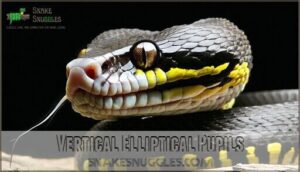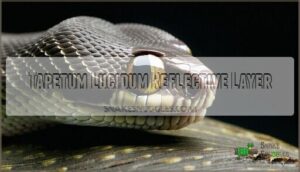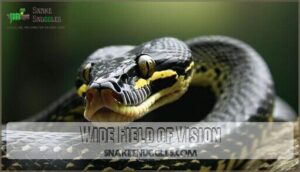This site is supported by our readers. We may earn a commission, at no cost to you, if you purchase through links.

Their eyes feature a reflective layer called the tapetum lucidum, which amplifies available light like nature’s night-vision goggles. Combined with wide-opening vertical pupils that capture maximum illumination, they can detect movement and changes in dim lighting.
However, their real superpower lies in heat-sensing pit organs that detect infrared radiation from warm-blooded prey.
While they need some ambient light for visual navigation, these thermal sensors let them "see" heat signatures when your eyes would fail completely, making them remarkably effective hunters even in near-total darkness.
Table Of Contents
- Key Takeaways
- Ball Python Vision
- Can Ball Pythons See in The Dark?
- Ball Python Eye Structure
- Visual Acuity and Field of Vision
- Daytime Activity and Vision
- Comparison to Other Snake Species
- Impact on Habitat and Behavior
- Frequently Asked Questions (FAQs)
- Can a ball python see in the dark?
- Do ball pythons like dark places?
- How many colors can a ball python see?
- How do ball pythons see at night?
- Can ball pythons see?
- Can ball pythons see blue and green?
- Do ball pythons need light at night?
- Do ball pythons like the dark?
- What do ball pythons do at night?
- Should I feed my ball python in the dark?
- Conclusion
Key Takeaways
- You can’t expect your ball python to see in complete darkness, but they excel in low-light conditions using specialized rod-rich retinas and a reflective tapetum lucidum that amplifies available light like natural night-vision goggles.
- Your snake’s real superpower isn’t vision but heat-sensing pit organs that detect infrared radiation from warm-blooded prey, allowing them to "see" heat signatures when your eyes would fail completely.
- You’ll notice your ball python’s vertical pupils can dilate dramatically in darkness while their wide 270-degree field of vision helps detect movement and changes in lighting across nearly their entire visual range.
- Your python relies heavily on thermal detection and scent during daylight hours when their vision becomes significantly reduced, then emerges at dusk when their nocturnal adaptations work most effectively.
Ball Python Vision
You’ve probably wondered whether your ball python can navigate their enclosure when the lights go out.
Ball pythons possess specialized night vision adaptations that allow them to detect movement and basic shapes in low-light conditions, though they can’t see in complete darkness without some ambient light.
Night Vision Capabilities
Ball pythons possess remarkable night vision capabilities that make them exceptional nocturnal hunters.
Their eyes contain specialized rod cells with a 10:1 rod-to-cone ratio, enabling superior low light sensing and dark adaptation.
These nocturnal sight adaptations allow them to detect movement and navigate effectively in dimly lit environments.
While they can’t achieve true infrared detection through their eyes alone, their visual system works seamlessly with thermal imaging from pit organs.
Their vertical pupils maximize light intake, creating impressive snake night vision that’s perfectly suited for their crepuscular hunting lifestyle in natural twilight conditions.
The ability to detect heat sensing abilities is essential for their hunting success in low-light environments.
Limited Color Vision
Unlike humans who see the world in vivid technicolor, your ball python’s Color Perception operates more like an old black-and-white TV with limited filters.
These snakes possess fewer cone cells than humans, restricting their Visual Limits substantially.
Your python’s world appears primarily in Gray Scale with some blue-green sensitivity.
- Limited color vision means reds and oranges likely appear as brownish hues
- Monocular Vision from each eye processes colors independently without depth integration
- Nocturnal vision prioritizes motion detection over color discrimination in Low Light conditions
Their vertical elliptical pupils maximize light intake rather than color clarity, making snake eyesight perfectly suited for lowlight vision hunting scenarios.
Depth Perception Limitations
While color vision poses challenges, depth perception creates even greater limitations for your ball python.
Monocular vision means each eye operates independently, preventing the overlapping visual fields that create accurate distance judgment.
Your snake compensates using visual clues like object size and movement patterns.
In low light conditions, these depth cues become harder to interpret, making spatial awareness more challenging.
| Vision Aspect | Ball Python Capability |
|---|---|
| Binocular overlap | Minimal field overlap |
| Distance accuracy | Relies on size/position cues |
| Low light judgment | Reduced spatial precision |
This explains why your python moves cautiously when exploring new environments.
Unique Eye Adaptations
Your python’s remarkable Eye Structure showcases sophisticated Low Light Adaptation for Nocturnal Sight.
These specialized features work together to enhance ball python vision beyond typical reptile capabilities:
- Vertical elliptical pupils – Control light intake like adjustable camera apertures for ideal nocturnal vision
- Tapetum lucidum reflective layer – Acts as a biological mirror, amplifying available light for enhanced low light vision
- Adjustable lens curvature – Provides variable focus capabilities, compensating for Visual Limits in depth perception
- Wide peripheral vision – Side-mounted eyes create expansive visual fields, complementing infrared sensing and Thermal Vision for thorough environmental awareness
These adaptations maximize snake heat vision effectiveness during nighttime hunting activities.
Can Ball Pythons See in The Dark?
Ball pythons can’t see in complete darkness, but they excel in low-light conditions thanks to specialized eye adaptations with abundant rod cells.
Their remarkable night vision combines with heat-sensing pit organs to create a dual detection system that makes them formidable nocturnal hunters.
How Ball Pythons Perceive Their Surroundings
Your ball python’s sensory systems work like sophisticated equipment, combining ball python vision with environmental cues for spatial awareness.
Their eyes detect movement and contrast changes, while nocturnal adaptations help them navigate dim conditions.
Though they can’t see in complete darkness, these infrared sensing experts use multiple thermal imaging capabilities alongside low light vision to map their world effectively.
Understanding their visual capabilities is essential for creating a suitable environment that supports their unique needs.
Role of Heat-Sensing Pit Organs
Heat-sensing pit organs give your ball python a remarkable advantage when hunting in darkness.
Your python’s thermal vision transforms darkness into a detailed heat map of living prey.
These specialized infrared detection systems work independently from their eyes, creating thermal imaging capabilities that surpass many technological devices.
Your python’s pit organs function through four key mechanisms:
- Thermal Perception – Detecting temperature differences as small as 0.003°F using TRPA1 ion channels that trigger nerve impulses when warmed
- Infrared Heat Sensing – Perceiving wavelengths between 5-30 micrometers, basically seeing heat signatures of warm-blooded prey
- Nocturnal Navigation – Combining thermal data with visual information in the brain’s tectum for spatial mapping
- Pit Organ Function – Operating like biological bolometers with rapid reset capabilities to avoid thermal afterimages
These heat-sensing pit organs provide your snake with a detection range up to ten feet, making them incredibly effective ambush predators.
The organs’ pinhole camera design offers wide-field thermal vision, allowing your python to track moving heat sources and distinguish between stationary and active prey even in complete darkness.
Pythons and boas have these thermal detectors located on their labial scales.
Importance of Ambient Light
Understanding ambient light’s role in ball python vision helps you provide better care.
Your snake can’t see in complete darkness, despite their impressive nocturnal adaptations.
They need minimal ambient light to navigate effectively, relying on their enhanced night vision capabilities in lowlight conditions.
Lighting Condition Vision Impact
Proper enclosure lighting supports their circadian rhythm and natural behavior patterns.
Light sensitivity varies among individuals, but most thrive with subtle dim lighting that mimics their dark environment adaptation.
This balance promotes vision health while respecting their nocturnal nature.
Ball Python Eye Structure
Ball python eyes feature three specialized structures that maximize their nocturnal hunting abilities.
You’ll notice their vertical elliptical pupils contract dramatically in bright light and dilate wide in darkness, while a reflective tapetum lucidum layer behind the retina amplifies available light.
Adjustable lens curvature helps focus on prey at varying distances, and this combined with the reflective layer, enhances their ability to hunt in low light conditions, making nocturnal hunting highly effective.
Vertical Elliptical Pupils
Every ball python’s eyes feature distinctive vertical elliptical pupils that function like natural night-vision goggles.
This unique pupil morphology represents a vital nocturnal adaptation, maximizing light intake during their active hunting hours.
Unlike round pupils, these vertical slits can dilate dramatically in darkness while constricting quickly in bright conditions.
The evolutionary advantage of vertical elliptical pupils becomes clear when you consider their hunting lifestyle:
- Enhanced light control – Pupils adjust rapidly between extreme light conditions
- Improved depth perception – Vertical orientation aids distance judgment for accurate strikes
- Superior motion detection – Elongated shape captures movement across wider visual fields
- Optimal night vision – Maximum pupil dilation allows greater light gathering capacity
This specialized reptile vision system transforms your ball python into an efficient nocturnal predator.
The vertical design works in perfect harmony with their rod-heavy retinas, creating snake vision that’s specifically engineered for low-light environments where most prey animals are active.
Tapetum Lucidum Reflective Layer
Behind your ball python’s retina lies a tapetum lucidum, a specialized reflective layer that acts like nature’s mirror.
This cellular structure reflects light back through photoreceptors, creating enhanced vision during nocturnal hunting.
While research remains inconclusive about its presence in ball pythons, this evolutionary advantage represents a vital nocturnal adaptation that potentially doubles available light for improved night vision capabilities.
Adjustable Lens Curvature
Your ball python’s adjustable lens curvature works like a camera’s autofocus system.
This lens accommodation allows precise focus mechanisms for different prey distances through controlled light refraction.
The curvature control enables sharp vision whether hunting nearby or distant targets, enhancing their python night vision capabilities as nocturnal animals with remarkable dark light sensitivity and python dark adaptation.
Their vision is roughly equivalent to 20/400 visual acuity.
- Watch your python’s eyes subtly shift focus when tracking movement across their enclosure
- Marvel at how this ancient predator evolved such sophisticated optical engineering millions of years ago
- Appreciate that your pet possesses the same hunting technology that made their wild ancestors apex nocturnal predators
Visual Acuity and Field of Vision
Ball pythons possess a remarkably wide field of vision that spans approximately 270 degrees, allowing them to detect movement and subtle changes in light across nearly their entire visual range.
However, their visual acuity remains limited compared to diurnal animals, with their eyes optimized for detecting motion and general shapes rather than fine detail resolution, which highlights their unique adaptation for detecting subtle changes.
Wide Field of Vision
Your ball python’s eyes sit strategically on the sides of its head, creating an impressive wide field of vision that spans nearly 270 degrees.
This peripheral vision advantage helps with prey detection and predator avoidance in their natural habitat.
The nocturnal hunter’s retinas packed with rods maximize visual range during nighttime activities, though binocular overlap remains limited compared to forward-facing predators.
Detecting Movement and Changes in Light
Motion Sensitivity in ball pythons stems from specialized photoreceptors in their retina that excel at detecting even minor movements.
These nocturnal hunters possess lower Flicker Fusion frequency than humans, making them incredibly responsive to shifting shadows and light changes.
Their Shadow Perception abilities help them navigate using Ambient Reliance on minimal illumination.
This Light Navigation system allows your snake to spot the slightest environmental shifts, from prey movement to changes in enclosure lighting, making them remarkably aware of their surroundings.
Limited Visual Acuity
Understanding snake vision requires recognizing that your ball python’s visual acuity remains quite limited despite excellent nocturnal vision.
Their retina contains high rod cell density but fewer cones, creating motion detection focus rather than sharp imagery.
Depth perception issues and limited color range mean they’re basically seeing a blurry world that prioritizes movement over detail, requiring ambient light needs for basic navigation.
Daytime Activity and Vision
During daylight hours, your ball python’s visual capabilities become substantially reduced compared to their impressive nighttime performance.
You’ll notice they rely heavily on their sense of smell and heat detection through specialized pit organs rather than their eyes when the sun is up, utilizing their heat detection capabilities to navigate.
Reduced Visual Capabilities
During daylight hours, your ball python’s vision becomes substantially compromised compared to their impressive nocturnal capabilities.
The Rod-Cone Ratio heavily favors low-light detection, leaving daytime Limited Acuity that resembles looking through frosted glass. Light Sensitivity forces them to squint and retreat, while Motion Detection remains their primary visual tool. Depth Perception struggles without ideal lighting conditions.
Key daytime visual limitations:
- Snake vision relies on rod cells that become oversaturated in bright light
- Snake eyes can’t adjust quickly from dark hiding spots to daylight
- Nocturnal vision adaptations work against them during peak sun hours
- Night vision specialization means daytime objects appear blurry and indistinct
- Heat-sensing pit organs compensate for reduced visual input during daylight
Reliance on Sense of Smell and Heat Detection
During daylight hours, your ball python compensates for reduced visual capabilities through sophisticated sensory integration.
These remarkable serpents rely primarily on olfactory hunting and thermal accuracy to navigate their environment effectively. Recent studies show that other snakes such as pit vipers also rely on specialized infrared sensors for hunting.
- Jacobson’s organ analysis: Specialized chemoreceptors process chemical information from tongue-flicking, creating detailed scent maps
- Pit organ thermal sensing: Infrared heat sensing detects temperature differences as small as 0.003°C for precise prey detection
- Heat detection tracking: Thermal signatures guide hunting strategies when visual cues become inadequate
- Sensory integration coordination: Multiple sensory inputs combine to form thorough environmental awareness
- Prey detection enhancement: Chemical and thermal cues work together, compensating for limited daytime vision capabilities
Emergence at Dusk or Early Evening
Your ball python kicks into gear when shadows start lengthening across their habitat.
These crepuscular hunters emerge from their hides during dusk or early evening, capitalizing on twilight vision and ambient light conditions.
Their nocturnal behavior patterns align perfectly with this timing, as pit organs and infrared heat sensing abilities complement fading daylight.
Evening activity peaks when thermal sensing through specialized snake sensory organs becomes most effective for detecting warm-blooded prey moving through cooler surroundings.
Comparison to Other Snake Species
When comparing ball pythons to other snake species, you’ll find their visual adaptations represent a middle ground between highly visual diurnal hunters and completely vision-dependent nocturnal predators.
Ball pythons combine moderate low-light vision with exceptional thermal detection, giving them unique advantages that many other pet snake species lack.
Unique Visual Adaptations
Your ball python’s vision stands apart from other snake species through several specialized features.
Their vertical pupils excel at light regulation, while high rod-cone ratios in their retinas maximize motion sensitivity during nocturnal activity.
These rods and cones create superior night vision despite limited acuity and minimal ultraviolet detection capabilities.
| Visual Feature | Ball Python Adaptation |
|---|---|
| Pupil Shape | Vertical elliptical for light control |
| Rod-Cone Ratio | 10:1 favoring low-light detection |
| Color Vision | Limited to blue-green spectrum |
| Motion Detection | Highly sensitive to movement |
| Field of Vision | 180-degree monocular coverage |
Advantages in Nocturnal Hunting
Nature’s blueprint for ball pythons gives you a front-row seat to their nocturnal hunting mastery. With night vision and infrared heat sensing, these ambush predators excel in low-light environments.
Their wide field of vision enhances Sensory Integration, allowing them to detect prey from multiple angles. Strike Precision and Thermal Accuracy set them apart, ensuring Hunting Success even when visibility drops.
Compared to other snakes, ball pythons’ combination of night vision and thermal detection is hard to beat. Here’s how they stack up:
| Species | Night Vision | Infrared Sensing |
|---|---|---|
| Ball Python | Yes | Yes |
| Corn Snake | Yes | No |
| King Snake | Limited | No |
Limited Color Vision and Depth Perception
Your ball python’s visual system operates quite differently from yours in the context of perceiving the world around them.
These fascinating reptiles possess monocular vision with significant visual limitations that affect both their color spectrum perception and depth perception abilities.
Ball pythons can’t distinguish colors the way you might expect.
Their color vision remains limited to specific wavelengths, making them most sensitive to blues and greens while struggling with reds and oranges.
This nocturnal snake vision adaptation serves their hunting lifestyle perfectly.
| Visual Aspect | Ball Python Capability |
|---|---|
| Color Range | Blues and greens primarily |
| Depth Judgment | Limited spatial awareness |
| Motion Sensitivity | Excellent movement detection |
| Night Vision | Enhanced low-light performance |
| Visual Acuity | Blurry compared to humans |
Their depth perception suffers due to monocular vision, where each eye works independently rather than creating the stereoscopic vision you experience.
However, their motion sensitivity compensates remarkably well, detecting even subtle movements that signal potential prey or threats in their environment.
Impact on Habitat and Behavior
Understanding your ball python’s visual limitations directly influences how you’ll design their habitat and manage their care.
Your snake’s nocturnal nature and specialized vision requirements shape everything from enclosure lighting to feeding schedules, making proper environmental setup essential for their wellbeing.
Terrestrial and Nocturnal Behavior
When darkness falls, ball pythons transform into efficient nocturnal hunters. Their terrestrial lifestyle keeps them grounded in grasslands and savannas, where they’ve mastered the art of nighttime predation. These Activity Patterns showcase remarkable Environmental Interaction through specialized Hunting Strategies.
Your snake’s Sensory Reliance becomes apparent as temperatures drop:
- Heat detection activates through pit organs for precise prey location
- Movement recognition increases dramatically in low-light conditions
- Ambush positioning occurs near rodent pathways and burrows
- Energy conservation during 20+ hour Sleep Duration periods
- Territory exploration peaks between dusk and dawn hours
This nocturnal lifestyle isn’t just preference—it’s survival strategy. Ball pythons avoid daytime predators while capitalizing on active rodent populations. Secure environments require proper habitat products to thrive. Their python sensory organs work overtime during these hours, creating a sophisticated snake sensory perception system that rivals any night vision technology.
Importance of Hiding Spots and Enclosure Setup
Your snake’s enclosure setup directly impacts its wellbeing and stress levels.
Enclosure Security requires at least two snug hiding places—one on the warm side, one on the cool side—to support proper Temperature Gradient thermoregulation.
Choose appropriate Substrate Choice and add Enrichment Items like branches or artificial plants for Hiding Variety.
Many keepers purchase specialized python enclosures for their pets.
This snake habitat design mimics natural burrows, creating a stable environment essential for successful ball python care.
Calm and Docile Nature
Through countless generations of evolution, ball pythons have developed remarkable temperament traits that make them exceptional pets for reptile enthusiasts.
Their docile genetics and calm demeanor directly influence how they interact with their environment and handlers.
Here’s how their temperament affects their behavior:
- Handling ease: Their naturally calm disposition allows beginners to develop confidence while learning proper snake care techniques and handling methods.
- Beginner friendliness: Unlike more aggressive species, ball pythons rarely bite or show defensive behaviors, making them ideal starter snakes for new reptile keepers.
- Temperament variations: Individual ball pythons may display slight personality differences, but most maintain consistent docile characteristics throughout their lives in captivity.
- Captivity benefits: Their relaxed nature means they adapt well to enclosure life, spending daylight hours resting peacefully before becoming active during nocturnal periods when their infrared detection and pit organs help them navigate and hunt using advanced sensory systems.
Ensuring proper housing includes selecting a suitable python enclosure to maintain their well-being.
Frequently Asked Questions (FAQs)
Can a ball python see in the dark?
Your scaly friend can’t see in complete darkness—they need some ambient light.
However, ball pythons excel in low-light conditions using rod-rich retinas and specialized pit organs that detect infrared heat signatures from warm-blooded prey.
Do ball pythons like dark places?
Like cave explorers relying on headlamps, you’ll find your ball python craves darkness for comfort and security.
These nocturnal hunters naturally seek shadowy retreats, spending 20-23 hours daily in dark hiding spots that mimic their wild burrow behavior.
How many colors can a ball python see?
Ball pythons have limited color vision with only two types of cone cells, allowing them to perceive primarily blues and greens alongside ultraviolet spectrum detection, unlike humans’ three-cone color system.
How do ball pythons see at night?
With rod cells outnumbering cones 10:1, you’ll find your ball python navigates darkness using specialized pit organs that detect temperature changes as small as 003°C, creating thermal images to hunt effectively.
Can ball pythons see?
Yes, ball pythons can see, but their vision is specifically adapted for low-light conditions.
They’ve rod-rich retinas that detect motion and shapes in dim environments, though they can’t see in complete darkness without some ambient light.
Can ball pythons see blue and green?
Your scaly friend isn’t completely colorblind—they’ve got limited color vision that’s most sensitive to blue and green wavelengths.
Their cone cells can detect these colors, though not as vividly as you’d see them, with limited color vision being the key characteristic.
Do ball pythons need light at night?
No, you shouldn’t provide light at night for your ball python. They’re naturally nocturnal and prefer complete darkness during nighttime hours to maintain their natural circadian rhythms and behaviors.
Do ball pythons like the dark?
Ball pythons absolutely love darkness and feel most comfortable in dim environments.
They’re naturally nocturnal creatures who thrive when you provide dark hiding spots and maintain nighttime conditions in their enclosure.
What do ball pythons do at night?
Like vampires awakening at sunset, your ball python transforms into a stealthy nocturnal hunter.
They’ll explore their enclosure, hunt for prey using heat-sensing pit organs, and engage in natural behaviors while you’re sleeping.
Should I feed my ball python in the dark?
You’ll want to feed during nighttime or dim conditions since ball pythons are naturally nocturnal hunters.
Their heat-sensing pit organs and night-adapted vision work best in low-light environments, making feeding more natural and successful.
Conclusion
Understanding how well can ball pythons see in the dark reveals their remarkable adaptation strategies.
These nocturnal hunters combine limited visual capabilities with extraordinary heat-detection systems.
Their tapetum lucidum and vertical pupils maximize available light, while specialized pit organs create thermal maps of their environment.
Though they can’t achieve true night vision like mammals, ball pythons successfully navigate darkness through this dual-sensory approach, making them effective predators despite relying primarily on heat signatures rather than visual acuity for hunting success.















